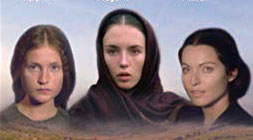|
|
|
|
The Brontë Sisters
|
 |
|
It
is too easy to dismiss André Téchiné’s The
Brontë Sisters as an extravagant arthouse failure. A failure it may be, but
its art-film pedigree – seemingly vouched for its high literary markings,
turgid pacing, painterly positioning of actors, excessive attention to costume
and décor, and mandatory “beautiful photography” – is, I think, questionable.
The
film becomes more intriguing once we point to the areas of cinematic and
fictional exploration from which it derives. Like a movie it resembles in many
respects, Stanley Kubrick’s Barry Lyndon (1975), The Brontë Sisters tantalises
with frequent glimpses of the work it could have been, or clearly wants to be. There
are, to be sure, fascinating things going on at the edges of The Brontë Sisters.
First,
consider the references: Téchiné, a gifted critic of the 1960s, who wrote on Carl
Dreyer in Cahiers du Cinèma; a
charming and fascinating cameo by Roland Barthes (whose famous essay on
Eisenstein, “The Third Meaning”, is dedicated to Téchiné, his former lover); a
script by Pascal Bonitzer, key Cahiers figure of the ‘70s (author of Le regard
et la voix in 1976) and Jean Gruault, a sophisticated collaborator of François
Truffaut and Jacques Rivette.
I
take The Brontë Sisters to be a sly
attempt to explode the rules of the historical-biography-of-famous-persons
genre from within. The fact, which so infuriated mainstream reviewers, that it
displays an almost comical lack of regard for historical fact, and hardly
mentions how and what the Brontës wrote – but projects their fiction, through a
weird twist, back into the representation of their lives – all this should be
enough to alert us to other intentions.
More
para– or meta-fiction than straight fiction, the film is full of fictional gestures
(a woman sits, then coughs violently and at length: first sign of a fatality
narrative) seemingly arrayed in quotation marks, but in a way that does not
correspond to camp or parody (hence audience problems with taking the film as
either serious or non-serious). And its fictional material – the stuff of the
19th century melodramatic novel – is constantly being edged into a set of
modern interpretative concerns: psychoanalysis of the Freudian “family romance”
and its identity positions; the shifting cinematic textuality of the
inscription of the look, the voice, the body in performance; a neo-formalist
fascination (à la Noël Burch, Jean-André Fieschi) with the slow, minute,
stylistic workings of the films of F.W. Murnau, Dreyer, Robert Bresson, Yasujiro
Ozu; possibly a re-heated religiosity (à
la Julia Kristeva and Philippe Sollers in the ‘80s) lurking as a pay-off at
the end of all this hard, materialist work.
The Brontë Sisters is valuable, at the
very least, for its slow-burning preview of a free cinematic lyricism (scenes
and shots arranged in the montage according to an unusual system of ebbing energies
and flows of intensity: prominent, abrupt swells of music; inserts of a raging
or placid sea; the textures of a rock face or a wall) that will truly come into
its own in a film such as Jean-Luc Godard’s Prenom:
Carmen (1983).
However,
the film is a failure – albeit a fascinating one – and there are three main
reasons why. It is in that Cahiers-motivated
mid ‘70s push to embrace mainstream fiction and Hollywood textuality but, in
doing so, to turn them inside out, make them strange, show their darker and
more delicious sides. However, the move to accommodate mainstream forms (like
the costume drama) here oversteps itself and the project topples; there is too
much the smell of compromise in the way Téchiné plays out the big-budget
requirements of this historical spectacle.
There
is also a related problem whereby the film gets too deep into the skin of the
fictional naturalism it seeks to discuss and disturb – and just ends up looking
like a badly realised ordinary film, with no really clear indication to the
typical arthouse audience that it is trying to do anything different with this
material.
The
third troubling facet of The Brontë
Sisters is the sense that it is coming around, very naively, to a
supposedly new understanding of melodrama – as symbolic fiction, as a play with
clearly defined iconic and social types (particularly in the theatricality of
its ending) – which, in fact, was well and richly understood by Hollywood
cinema (Douglas Sirk, Vincente Minnelli, George Cukor, plus a host of lesser
lights) at least 40 years previously.
In
this, it makes an interesting double with another work of its time and context,
Jean-Louis Comolli’s La Cecilia (1975).
Both films make for a diverting theory/practice case study, and should not just
be written off as botched jobs. But for a successful, indeed profound film from
the same cultural milieu, immediately find Benoît
Jacquot’s Les Enfants du placard (1977), one of the great unknown gems of French cinema.
MORE Téchiné: Loin, Alice and Martin, Wild Reeds © Adrian Martin August 1985 |
![]()